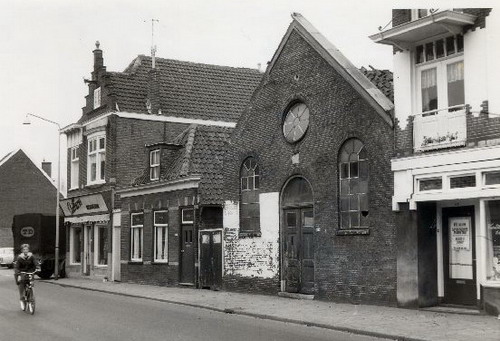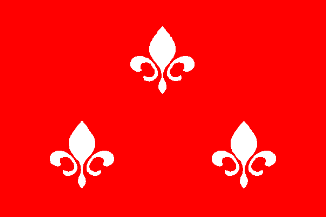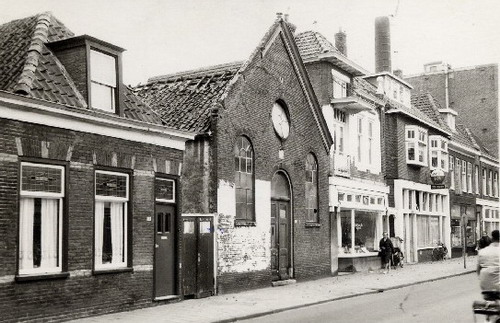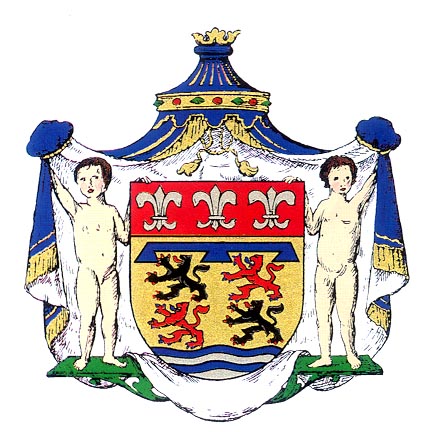The Jews of Beverwijk
The first Jews in Beverwijk
Because no archive has been preserved in Beverwijk, it is difficult to establish when the first Jews came to live there. At the start the Jews in Beverwijk were not an important factor in the community . Almost no distinct traces of Jews were found, except some hidden tombstones in the general cemetery Duinrust.
The only preserved document is a prohibition issued by the Court on 30th March 1679, forbidding strangers or "smousen" to peddle wool, linen, cotton, or other materials. "Smousen" was the nickname for Jews.
Most Jews were descendants of German or Polish refugees, arriving in the 17th century, but there were also Portuguese Jews from the Iberian peninsula. Around 1700, when there was already a mention of a Jewish community in Haarlem, there was no trace of such a community in Beverwijk.
The oldest reference, hinting at a Jewish source, is taken from the official marriage register from 1655, where Joseph da Silva, a young man from Lisbon, Portugal, announces his marriage to Rachel Steves, the youngest daughter of Hennburgh, both living in this town. Afterwards no further mention of da Silva is found.
The next mention was found in the burial register: on the 25th February 1740, an unknown Jew died in the hospital, and was buried here. Afterwards mention is made of the Jew Abraham Rood, baptized in the Hervormde Church in February 1766.
Only towards the end of the 18th century more Jews are are found in the registers. In the marriage registers after 1780, regular entries are found of marriages between Jews living in Beverwijk.
In 1784 Jacob Levy Cohen, butcher in Uitgeest, filed a request to settle in Beverwijk. It was not granted, but in 1790 he tried again and received the requested permit. The fact that a Jewish butcher wanted to settle there, proved the existence of a Jewish community, in need of their own food, prepared in accordance with their own rites.
Then, still in existence, is the only preserved circumcision register, opened by the "Gabbai" David Davidson, according to which the first circumcision took place on 11 March 1793. During that time there was no synagogue in Beverwijk. In 1797 however, Beverwijk certainly had a synagogue, proving that more than ten men lived there.
Most likely this was a home synagogue, as can be concluded from a letter from 1808, written by Leendert Abrahams, a trustee of the Ashkenazi community of Beverwijk to the Landdrost. Abrahams mentions that 66 Dutch Ashkenazi Jews lived in Beverwijk, but no Portuguese Jews.
"They had no church of their own, but hired a room to be used as a church, for 36 guilders a year. No property and the income is derived from the weekly contribution and offerings from the members, supporting the needs of the church."
In 1806 a teacher, named David Lesser, is mentioned. He taught the children reading and writing. Obviously he was also the cantor, probably the first one in Beverwijk. He didn't stay very long, since in 1809 he moved to Haarlem.
The relations between King Lodewijk Napoleon and the Jews were good. During his visit to Beverwijk in 1807, the Jewish Community presented him with a Hebrew poem with Dutch translation. The King propagated the equality of the Jews, he took care to move the weekly market from Saturdays to another day, in order to enable the Jewish merchants to take part in it.
He also ordered that from now on Jews should be called by their proper names: Dutch Jews or Israelites, and if necessary Ashkenazi or Portuguese could be added.
In order to achieve a quick integration he ordered the preference of the Dutch language over Yiddish. His linguistic policy would be continued by King Willem I.
King Lodewijk Napoleon even asked the Jewish community whether the authorities did cause them any inconvenience. The reply of Leendert Abrahams from 1808, proved that during the last ten years such had not been the case. The Jews were not even burdened with the billeting of passing soldiers on the Sabbath, as were regular citizens.
The synagogue
One of the first Parnassiem, Jacob Levy Cohen, formulated the necessary rules regarding general behavior in the synagogue, probably a home synagogue. According to the minutes of the mayor and the municipal council of Beverwijk, quite some instances of disorderliness must have occurred. Rude behavior and disorder, especially during prayers, were registered. At a certain moment the city council found it necessary to interfere. A public declaration of the municipal secretary, hinting that the synagogue could be closed, did not improve the situation and the disturbances continued.
Therefore, in June 1808, the Parnas of the Jewish community begged the authorities of the Parliament of Amstelland to intervene. The Parnas was near despair, as may be concluded from the closing sentence of his letter: "One God created us."
Finally the Landdrost decided to have a look for himself. No agreement could be reached between him, the city council and the representatives of the Jewish community. Therefore it was decided to present the case to the Minister of Worship. Thanks to his intervention a solution was finally found.
Now it became possible to give thoughts about a real synagogue of their own. A house in the Breestraat, bearing the name "Spes mea Deus" (God is my hope), was chosen.
In March 1810 Hendrik van Riesen sold the house to the Ashkenazi Jewish Community for an amount of 650 guilders. The members of the Jewish community of Beverwijk did not belong to the most prosperous classes but with some adjustments the building became fit to serve as a synagogue.
The Jewish community was too small and too poor to afford a rabbi of their own. Only barely were they able to have a cantor. For special prayers they invited a rabbi from another town to hold the service. The synagogue was registered as a secondary one, and resorted under the Jewish community of Haarlem.
At the start of September 1829 the Jewish synaguoge council filed a request with mayor J. de Quack to install a new drainage, from the synagogue to the general gutter of the Breestraat. The request was rejected. The reason given was that the stench might cause inconvenience to the neighbors. In order to solve the problem it was suggested to install a cemented gutter and a plate with little holes, but this was not permitted either.
Since a similar request was permitted to the nearest neighbors, the representatives of the synagogue leadership applied to the Governor of North Holland, who tried to settle the matter amicably. He ordered the mayor to consent, but the request was rejected again.
Since the Jewish community claimed the same rights as others, who had received the requested permission, they applied again to the Governor. By decision from January 1830 the community of Beverwijk was put in the wrong and had to allow the Jewish Community to connect their sewage to the general gutter of the Breestraat, provided the mentioned plate would be installed.
In the fall of 1853 Beverwijk was damaged by heavy storms, which also caused serious damage to the synagogue. There were no available funds for repairs. Even before the storm the synagogue was in a bad situation, which may be deducted from a letter to mayor C. Stumphius, requesting his support for a grant of 400 guilders, addressed to King Willem II, to be used for urgent repairs of the building.
The repairs were not executed, which may be concluded from a reaction of the municipality, warning that the building should be closed, and probably demolished.
After many problems, mainly due to lack of funds, and more damage as a result of the Pentecost storm of 1860 - it seems that there even had been a fire - the restored synagogue was finally reopened in 1863.
It was a joint effort of the Jewish community, the state, the province, the municipality of Beverwijk, and several towns like Amsterdam, the Hague and Rotterdam.
In April 1870 the municipality of Beverwijk received a petition to hold Evangelic Protestant prayers in premises about 200 meters from the synagogue. The municipality had no objection, but requested a written agreement from the governors of the synagogue. They did agree, but under some provisions. No organ should be used in the premises, and no organ should even be kept there.
After the agreement had been signed, the matter seems to have been settled and any further trouble obviously came from the Jewish community itself.
As from 1869 the services were again regularly disturbed, even after a policeman had been posted there. In 1870 the disorderliness became very serious. So serious, that the public prosecutor requested the mayor to post a policeman before the home of the churchwarden of the synagogue, in order to prevent further molestation.
During meetings at his house, serious differences of opinion had arisen between him and the parnasiem. When the mayor himself tried to mediate, and a solution seemed very near, the matter got even worse. It became a terrible quarrel, mainly about seating arrangements in the synagogue and the functioning of the cantor.
Only after intervention of the public prosecutor, peace reigned again, as reported by the Jewish weekly, the Nieuw Israelitisch Weekblad.
In 1872 however, the parnasiem called again upon the municipal council, begging for assistance. The quarrel was again about the payment of dues and the seating arrangements, by two members of the community. Finally a settlement was reached, with the assistance of the municipality.
In spite of all difficulties, the silver jubilee of the synagogue was held in 1889.
For this occasion the synagogue was spruced up. The Mayors and Aldermen of Beverwijk and Wijk aan Zee, other local notables and clergy took part in the ceremony. After the usual ceremonial the cantor gave a speech, stressing the importance of having a synagogue. The jubilating community received several presents, including a tapestry for the Holy Ark and a red velvet cloth for the "Bimah."
During the ceremony the cantor announced that a group of youngsters had come together, with the purpose of acquiring a new Torah roll.
In 1922 a general renovation was executed. The Jewish archive has been sadly lost and in the minutes of the municipality council nothing could be found regarding about this . In 1941 the interior of the synagogue was demolished by the Germans, whereupon the services were continued at the cantor's home. In 1942 the remainder of the synagogue's interior was confiscated. Finally, after the war the synagogue was sold and taken down.
Jewish school
During the second half of the 19th century, after 1840, there was an economic boom, and the Jewish community of Beverwijk grew. In 1873 it became necessary to build a Jewish school.
Jewish cemetery
Initially the Jews of Beverwijk were buried in the Jewish cemetery "the Bolwerk" in Haarlem. Afterwards a small parcel of land was purchased at 36 guilders, named the "Kruiskrogt" at the "Kuikensweg" in Wijk aan Zee, called "Jodenweg" in popular language. In 1854 the cemetery was enlarged, i.a. for the building of a "metaher house."
In 1951 the cemetery was evacuated, because the spot had become too near to the built-up area. On account of the municipality the graves were transferred to a special part of the general cemetery of "Duinrust" in Beverwijk. There were 45 tombs, the oldest one from 1848. It seems that the remainder of about 100 tombs has been lost. The remaining tombs were also buried at Duinrust. The remaining graves have been registered in the "Stenen Archief."
Social provisions
The first years of the Jewish community were still hopeful, but later on the community fell into abject poverty, just like the local population. While before 1813 there were still 20 Jewish families in Beverwijk, their number slowly dwindled to five or six. It became therefore almost impossible to hold joint prayer services.
The debt of the synagogue had not yet been paid and the cantor lived with his family in terrible poverty. According to a report to the municipality from 1811, there were ten needy Jewish families in Beverwijk.
Also in 1821 the situation had not been improved. From a letter of one of the Parnasiem we learn that the 58 souls of the Jewish community were hardly able to support their poor members. The collections were not enough and they filed a request to be considered for public assistance.
From a preserved invoice from 1822 we learn several facts. The expenses for the reparation of the synagogue were quite high. Expenses were made for a doctor for the needy and for passing members of the faith, who stayed overnight in Beverwijk.
Probably a committee for the poor was formed, because in the municipal reports appear regular entries for subsidies. The members of this committee are unfortunately unknown.
Since the Jewish community and synagogue had no assets, like houses or land, which was usual for other local churches, they lived a destitute existence. Since the Jews were not allowed to collect funds in the synagogue on Saturdays, the municipality allowed them to collect money four times a year. They did not succeed however in building a real fund.
The social provisions were not good at the time. The Jewish committee for the poor had to ask for assistance in order to help an old blind man of 81 years. There was a widow living with three children and an old mother. She received 23 guilders a year from the committee, which was not sufficient. Since the little children were unable to earn anything, the committee requested assistance from the municipality of Beverwijk. They refused with the excuse that this was the task of the social department. The Jewish committee for the poor sent a supplication to King Willem III who replied that he was unable to remedy the situation, but he sent an amount of 10 guilders as relief.
In 1872 the Jewish committee for the poor, together with the Lutheran and Hervormd congregations, filed a complaint that they, unlike the Roman Catholic committee for the poor, were discriminated. The council replied that more Roman Catholics were living in poor circumstances.
Only with the introduction of the General Social Law of 1963 the situation really changed. Till then the care for the Jewish poor, remained a problem of the Jewish community.
Means of support
In a saved patent register from 1806,the following Jewish professions were registered: A butcher and assistant, a teacher, a carver and assistant, three vendors of lottery tickets, and nine who peddled local and foreign merchandise. Most Jews in Beverwijk earned a living from some sort of business and from the sale of lottery tickets, which stayed in Jewish hands till the end of the 19th century. Sometimes they owned a shop, which was often the front room of their house.
Even after 50 years not much change was recorded. In a letter from Mayor Stumphius to the Governor of North Holland, the Mayor mentions that the Jewish population was mainly composed of needy merchants and peddlers of goods.
Nevertheless there also were other professions, like a dance teacher and a musician. Later on there was a cinema and theater in Jewish hands and there also lived a few Jewish writers in Beverwijk.
Summary
At the start of the 19th century the Jewish community in Beverwijk was of no great importance, but during the second half of the century the community enjoyed a certain growth, continuing till the twenties of the 20th century. Then a growing Jewish community was created in Velsen.
Between 1935 and 1938 a sort of "kibbutz" was erected in Beverwijk. It was started by three Zionistic young men, who planned to receive their training for their life in Palestine. Their stay was coordinated and financed by the local Jewish community.
In October 1935 this "kibbutz" was established under the name: "Chinoeg Habayit"
For many years the Jewish community counted 130 members.
Seventy nine people were transported and did not return from the extermination camps. In 1947, after the war, a remnant of 17 people remained .
In the nineties of the 20th century, a monument in memory of the synagogue of Beverwijk was erected by students of the building industry together with the municipal council of Beverwijk.
Source:
Book: From "Matses met Aardbeien", de geschiedenis van de Joodse inwoners van Beverwijk,
by J. van der Linden
Uitgave: Velsen-Noord : De Tunnel, 1997., 64 p.
ISBN 90-803365-1-3
With data from the website of the Joods Historisch Museum
Extracted from the source:Yael Benlev-de Jong
Translation into English:Mechel Jamenfeld
Editing:Ben Noach
Final review:Hanneke Noach
[an error occurred while processing this directive]
[an error occurred while processing this directive]

|
| Synagogue building of Beverwijk (demolished) |

|
| City Arms |

|
| Synagogue building of Beverwijk (demolished) |

|
| City Arms |